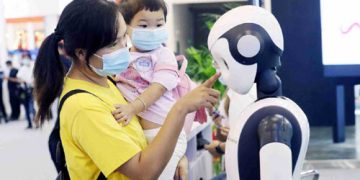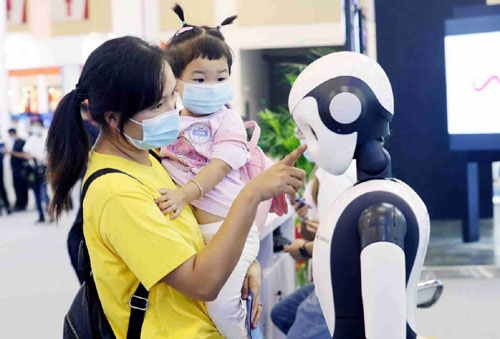China is aiming to become an innovation hub for the global robotics industry by 2025, as it works to achieve breakthroughs in robotics components and widen the application of smart machines in more sectors. The move is part of the nation’s broader push to cope with a graying population and leverage cutting-edge technologies to advance industrial upgrades, experts said.
The Ministry of Industry and Information Technology said in a five-year plan released on Tuesday that the operating income of China’s robotics industry is expected to grow at an average annual rate of 20 percent from 2021 to 2025.
China has been the world’s largest market for industrial robots for eight consecutive years. In 2020, the manufacturing robot density, a metric used to measure a country’s level of automation, reached 246 units per 10,000 people in China, nearly twice the global average.
Wang Weiming, an official with the ministry, said China aims to double its manufacturing robot density by 2025. High-end, advanced robots are expected to be used in more sectors such as the automobile, aerospace, railway transportation, logistics and mining industries. More efforts will also be made to achieve breakthroughs in core robot components, such as speed reducers, servomotors and control panels, which are recognized as the three basic building blocks of sophisticated automated machines, Wang said.
“The goal is that by 2025, the performance and reliability of these homegrown key components can reach the level of advanced foreign products,” Wang said.
From 2016 to 2020, China’s robotics industry grew rapidly, with an average annual growth rate of about 15 percent. In 2020, the operating income of China’s robotics sector exceeded 100 billion yuan ($15.7 billion) for the first time, data from the ministry show.
In the first 11 months of 2021, the cumulative output of industrial robots in China exceeded 330,000 units, marking year-on-year growth of 49 percent, according to the National Bureau of Statistics.
Song Xiaogang, executive director and secretary-general of the China Robot Industry Alliance, said robots are important carriers of emerging technologies. As key equipment for modern industries, robots can lead an industry’s digital development and upgrades of intelligent systems.
Meanwhile, service robots can also serve as assistants to an aging population and improve people’s quality of life.
Thanks to technologies such as 5G and artificial intelligence, service robots can play a bigger role in elderly healthcare, Song said.
The International Federation of Robotics predicted that globally industrial robot installations are expected to rebound strongly and grow by 13 percent year-on-year to 435,000 units in 2021, despite the COVID-19 pandemic, exceeding the record achieved in 2018.
Milton Guerry, president of the federation, said that industrial robot installations in Asia are expected to exceed 300,000 units this year, a 15 percent year-on-year increase. The trend has been fueled by the positive market developments in China, the federation said.
Deng Xiaobai, co-founder and CEO of Dorabot, a Chinese AI-powered robotic solutions provider for logistics and other industries, said he is excited by the five-year plan. “The COVID-19 pandemic has driven changes in the logistics industry, which includes the acceleration of innovation, automation and digitalization in the workplace,” Deng said. “We are optimistic about future development.” – CHINA DAILY
- Latest
- Trending





